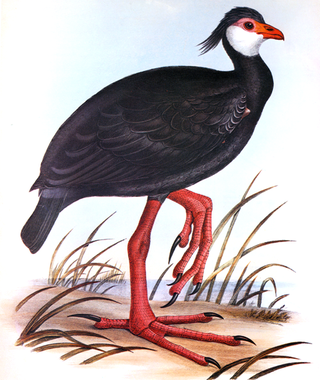
George Robert Gray was an English zoologist and author, and head of the ornithological section of the British Museum, now the Natural History Museum, in London for forty-one years. He was the younger brother of the zoologist John Edward Gray and the son of the botanist Samuel Frederick Gray.
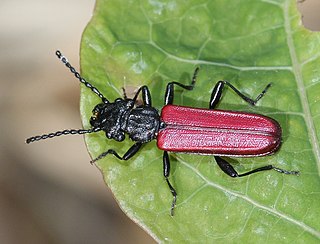
The Cucujidae, or flat bark beetles, are a family of distinctively flat beetles found worldwide under the bark of dead trees. The family has received considerable taxonomic attention in recent years and now consists of 70 species distributed in five genera. It was indicated Cucujus species are scavengers, only feeding on pupae and larvae of other insects and on other subcortical beetles such as their own. Since the Cucujidae prey on larvae of potentially tree damaging beetles that spread fungal diseases, they are considered to be beneficial to the health of living trees.

Pseudopanax is a small genus of 7 species of evergreen plants which are endemic to New Zealand. Flowers of the genus occur in terminal umbels.

Adam White was a Scottish zoologist.

The seashore earwig is a species of earwig in the family Anisolabididae. The species was first described in 1846 by Adam White. This species has a blackish-brown body about 35mm long, with brown-yellow legs. It has two light brown spots on its head, close to the inside of each eye. Its abdomen is widest at the seventh segment. It is flightless. It is native to eastern Australia and New Zealand. Similar both ecologically and taxonomically to the maritime earwig, this species is commonly found on beaches under stones and debris. It is a carnivore, feeding on millipedes, flies, and isopods such as woodlice. Like most other earwigs, the females care for their young during development, and the larva go through five instars before becoming adults. The species also has a negative phototaxis, meaning that it tends to move away from a light source.

Pericoptus punctatus is a sand scarab beetle that is endemic to New Zealand. It is a smaller and similar New Zealand scarab beetle species to Pericoptus truncatus.

The Ditomyiidae are a small family of flies (Diptera).They are found worldwide, most species are found in the Australasian and Neotropical realms. There are only two genera in Europe Ditomyia Winnertz, 1846 and Symmerus Walker, 1848 Ditomyia is found in Central Europe Symmerus in Northern Europe Symmerus is endemic to the Palaearctic.
Phenacoleachiidae is a family of scale insects commonly known as the phenacoleachiids. They are found only in the South Island of New Zealand, and on certain offshore islands. There are two species in a single genus.

Heterocrossa exochana is a species of moth in the family Carposinidae. It is endemic to New Zealand and has been observed in the North and South Islands. The larvae of this species feed on the fruits of Muehlenbeckia species. The adult is on the wing from September until May and are attracted to light.
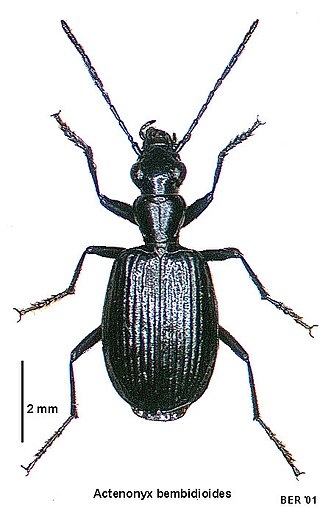
Actenonyx is a genus of beetles in the family Carabidae. At present only species in this genus is Actenonyx bembidioides. However, it has been suggested that a taxonomic revision of this genus is needed as there are two species that await description. This genus and species was first described by Adam White and is endemic to New Zealand.

Clitarchus is a genus of stick insects in the Phasmatidae family and Phasmatinae sub-family. This genus is the most common stick insect in New Zealand. It is found widely throughout the North Island and part of the South Island on kanuka and manuka, as well as various common garden plants.

Molopsida is a genus of beetles in the family Carabidae, endemic to New Zealand. This genus was first described by Adam White (zoologist) in 1846. Molopsida includes the following six species:
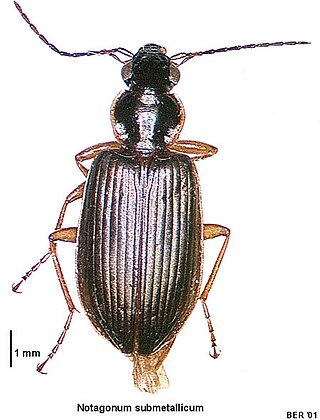
Notagonum submetallicum is a species of ground beetle in the subfamily Platyninae. It was described by Adam White in 1846.
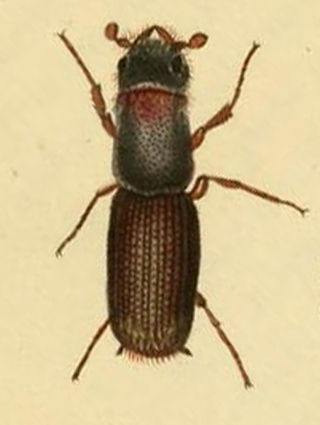
Platypus is a weevil genus in the subfamily Platypodinae.

Tetrorea cilipes is a species of beetle in the family Cerambycidae. It was described by Adam White in 1846. It is known from New Zealand. The larvae of T. cilipes are known to make a distinct clicking sound.

Scolopterus penicillatus, also known as the black spined weevil, is an endemic beetle of New Zealand. The beetle is present throughout New Zealand and can be discovered by beating native flowering plants in the summer months. In appearance it is a shining black colour with a purplish tinge and looks very similar to its close relative Scolopterus tetracanthus. S. penicillatus can be distinguished from S. tetracanthus as the spines on the shoulders of the former are much less pointed. Adult black spined weevils have been collected from Hedychium gardnerianum and caught in the flowers of Helichrysum lanceolatum. The larvae of S. penicillatus are known to develop in the recently dead bark of the various species of Pseudopanax.
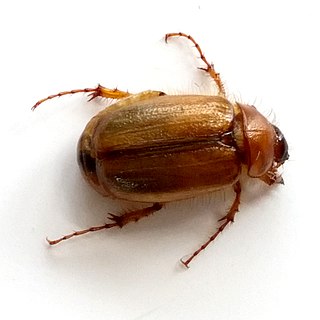
Costelytra zealandica is a species of scarab beetle found in forested areas of greater Wellington. It was originally described in 1846 by the British entomologist Adam White as Rhisotrogus zealandicus from a specimen obtained during the Ross expedition. The species is known to feed on roots of plants and trees, so is considered a pest for many farm pastures.

Lycorma imperialis is a planthopper indigenous to parts of China and Indo-Malaysia. L. imperialis was originally discovered in 1846 by Adam White and has one recognized non-nominate subspecies, L. i. punicea. L. imperialis has undergone a number of reclassifications since its discovery and is one of four species in the genus Lycorma. L. imperialis follows a hemimetabolous life cycle and will undergo a series of nymphal stages (instars) before maturing to an adult.

Scolopterus tetracanthus, more commonly known as the four-spined weevil, is a beetle of the genus Scolopterus, first described by A. White in 1846, and endemic to New Zealand.


















